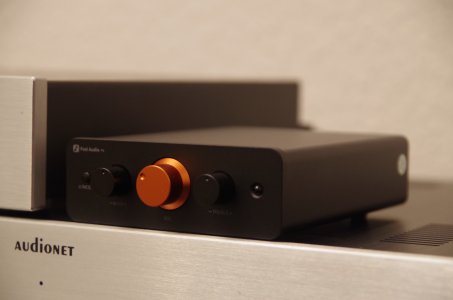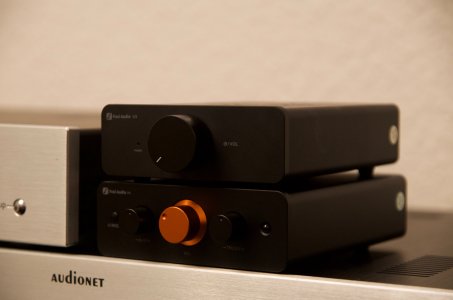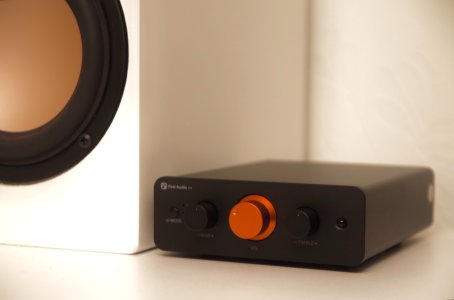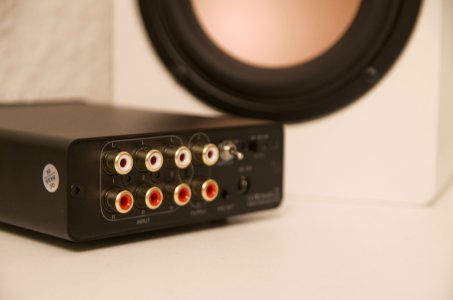Introduction
As a longtime hi-fi enthusiast, I am always on the lookout for affordable yet high-quality audio equipment. The Fosi Audio P4 preamplifier caught my attention, as Fosi Audio is known for compact and powerful audio products. With its versatile features, three RCA inputs, and finely tuned tone controls, the P4 promises flexible and high-quality signal processing. I tested the device over several weeks in different setups and was surprised by how well it integrated into various configurations.
Design and Build Quality
Right out of the box, the P4 makes a high-quality impression. The aluminum housing feels sturdy and contributes to heat dissipation, while the compact design makes it a discreet addition to any audio system. The controls are well-arranged and intuitive to use. Particularly noteworthy is the smooth operation of the volume potentiometer.
The P4 features three RCA inputs, allowing multiple audio sources to be connected simultaneously. Switching between them is done via a button that provides satisfying tactile feedback. In addition to volume control, the device offers a three-stage gain adjustment of 0, 3, and 6 decibels, enabling adaptation to different amplifiers and speakers. The tone controls for treble and bass are precisely tuned and can be finely adjusted via rotary knobs. For those who prefer an unaltered sound, the bypass mode allows the tone control to be completely bypassed.
Sound Quality
A preamplifier should not color the sound but rather pass the signal to the amplifier as transparently as possible. The P4 meets this requirement with remarkable neutrality and clarity. Vocals and instruments are reproduced with precision, without any frequency range being overly emphasized or diminished.
During testing with various audio sources, including an Audionet ART G3 and an Audionet DNP, the playback remained consistently detailed and balanced. In combination with an Audionet PAM G2 phono preamplifier, the P4 proved to be an ideal addition for vinyl enthusiasts. A particularly positive aspect was the absence of audible background noise, even with sensitive speakers.
The tone controls allow for subtle adjustments to personal preferences. A slight boost in the bass adds warmth to certain speakers without making the sound feel artificial. The treble adjustment can soften slight harshness in high-resolution recordings without sacrificing detail.
In direct comparison with other preamplifiers, the P4 was quite convincing. Compared to an older Audionet PRE I G3, it sounded analytical but not sterile. In contrast to an Audionet PRE G2, it lacked a bit of spatial depth, which is unsurprising given the significant price difference.
Practical Experience and Usability
The Fosi Audio P4 impresses with its straightforward operation. The clear labeling and logical arrangement of the connections make setup easy. Input selection is quick and interference-free, and the gain adjustment allows for optimal integration into an audio system.
In my test, the P4 worked seamlessly with various amplifiers, including an Audionet AMP I V2, two Audionet AMP units, and an Audionet SAM G2. The device's flexibility was particularly evident in its ability to accommodate multiple sources—such as a CD player, an external DAC, and a turntable—without compromising sound quality.
The only drawback is the absence of balanced XLR inputs, which could be beneficial in professional settings or very high-end hi-fi systems. However, considering its price, this is hardly a downside, as the P4 already offers an exceptional range of features for its class.
Conclusion
The Fosi Audio P4 proves to be a powerful and versatile preamplifier suitable for a wide range of audio applications. Its high-quality build, flexible input selection, and precise tone control make it an excellent solution for audiophiles looking to enhance their system with a reliable preamp.
Particularly impressive is the device’s sonic neutrality, which preserves the character of connected sources and amplifiers without alteration. The three-stage gain adjustment allows for flexible adaptation to different applications and audio sources.
As a longtime hi-fi enthusiast, I am always on the lookout for affordable yet high-quality audio equipment. The Fosi Audio P4 preamplifier caught my attention, as Fosi Audio is known for compact and powerful audio products. With its versatile features, three RCA inputs, and finely tuned tone controls, the P4 promises flexible and high-quality signal processing. I tested the device over several weeks in different setups and was surprised by how well it integrated into various configurations.
Design and Build Quality
Right out of the box, the P4 makes a high-quality impression. The aluminum housing feels sturdy and contributes to heat dissipation, while the compact design makes it a discreet addition to any audio system. The controls are well-arranged and intuitive to use. Particularly noteworthy is the smooth operation of the volume potentiometer.
The P4 features three RCA inputs, allowing multiple audio sources to be connected simultaneously. Switching between them is done via a button that provides satisfying tactile feedback. In addition to volume control, the device offers a three-stage gain adjustment of 0, 3, and 6 decibels, enabling adaptation to different amplifiers and speakers. The tone controls for treble and bass are precisely tuned and can be finely adjusted via rotary knobs. For those who prefer an unaltered sound, the bypass mode allows the tone control to be completely bypassed.
Sound Quality
A preamplifier should not color the sound but rather pass the signal to the amplifier as transparently as possible. The P4 meets this requirement with remarkable neutrality and clarity. Vocals and instruments are reproduced with precision, without any frequency range being overly emphasized or diminished.
During testing with various audio sources, including an Audionet ART G3 and an Audionet DNP, the playback remained consistently detailed and balanced. In combination with an Audionet PAM G2 phono preamplifier, the P4 proved to be an ideal addition for vinyl enthusiasts. A particularly positive aspect was the absence of audible background noise, even with sensitive speakers.
The tone controls allow for subtle adjustments to personal preferences. A slight boost in the bass adds warmth to certain speakers without making the sound feel artificial. The treble adjustment can soften slight harshness in high-resolution recordings without sacrificing detail.
In direct comparison with other preamplifiers, the P4 was quite convincing. Compared to an older Audionet PRE I G3, it sounded analytical but not sterile. In contrast to an Audionet PRE G2, it lacked a bit of spatial depth, which is unsurprising given the significant price difference.
Practical Experience and Usability
The Fosi Audio P4 impresses with its straightforward operation. The clear labeling and logical arrangement of the connections make setup easy. Input selection is quick and interference-free, and the gain adjustment allows for optimal integration into an audio system.
In my test, the P4 worked seamlessly with various amplifiers, including an Audionet AMP I V2, two Audionet AMP units, and an Audionet SAM G2. The device's flexibility was particularly evident in its ability to accommodate multiple sources—such as a CD player, an external DAC, and a turntable—without compromising sound quality.
The only drawback is the absence of balanced XLR inputs, which could be beneficial in professional settings or very high-end hi-fi systems. However, considering its price, this is hardly a downside, as the P4 already offers an exceptional range of features for its class.
Conclusion
The Fosi Audio P4 proves to be a powerful and versatile preamplifier suitable for a wide range of audio applications. Its high-quality build, flexible input selection, and precise tone control make it an excellent solution for audiophiles looking to enhance their system with a reliable preamp.
Particularly impressive is the device’s sonic neutrality, which preserves the character of connected sources and amplifiers without alteration. The three-stage gain adjustment allows for flexible adaptation to different applications and audio sources.





